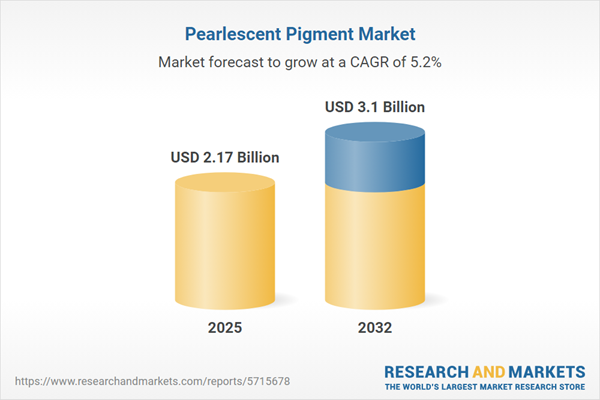Speak directly to the analyst to clarify any post sales queries you may have.
The pearlescent pigment market is undergoing significant change as environmental priorities and evolving supply chain strategies become central to business operations. Senior decision-makers are adopting agile approaches, seeking sustainable solutions, and leveraging technology to capture new market opportunities and protect organizational resilience.
Pearlescent Pigment Market Snapshot
In 2024, the global pearlescent pigment market achieved a value of USD 2.06 billion, driven by progress across automotive, packaging, personal care, and industrial manufacturing sectors. This momentum is projected to continue, with the market expected to reach USD 2.17 billion in 2025 and expand to USD 3.10 billion by 2032, advancing at a 5.22% CAGR from 2025 through 2032. Investments in sustainable sourcing and ongoing technical improvements are building long-term market momentum. Industry leaders are proactively streamlining operations, improving supply chain risk management, and exploring new applications to align with customer needs and secure consistent delivery in a shifting landscape.
Pearlescent Pigment Market: Scope & Segmentation
This report delivers tailored strategies suitable for procurement, product development, and partnership formation, guiding leaders through rapidly evolving pearlescent pigment market trends. Detailed segmentation provides clarity on growth opportunities and helps organizations strengthen operational performance in response to dynamic market factors.
- Form: Liquid dispersions allow straightforward integration within water-based formulations and boost operational flexibility, whereas powder pigments offer longer shelf life and are better suited to solvent-based manufacturing environments.
- Type: Natural mica supplies high-end finishes suitable for luxury and premium products. Synthetic fluorophlogopite ensures batch consistency, essential for controlled and repeatable technical processes. Synthetic pearls contribute to design flexibility, while titanium dioxide enhances both opacity and functional properties for advanced industry uses.
- Application: The versatility of pearlescent pigments covers automotive and construction coatings, cosmetics for visual appeal, packaging and plastics aimed at brand differentiation, printing inks for diverse substrates, and textiles supporting dynamic coloration effects.
- End Use: Automotive end uses emphasize surface durability, construction relies on functional protections, packaging spans consumer products and regulated healthcare or food items, and personal care incorporates advanced pigments to support innovative product development.
- Regions: The analysis encompasses the Americas, Europe, Middle East & Africa, and Asia-Pacific, evaluating evolving regulations, digital adoption trends, and shifts in sourcing strategies that influence regional growth pathways.
- Leading Companies: Key industry competitors evaluated include Merck KGaA, BASF SE, Eckart GmbH, DIC Corporation, Venator Materials PLC, Clariant AG, Ishihara Sangyo Kaisha Ltd., Sudarshan Chemical Industries Ltd., Kobo Products Inc., and Ferro Corporation.
Pearlescent Pigment Market: Key Takeaways for Senior Decision-Makers
- Technological advancements in pigment formulations are enabling organizations to manage evolving regulatory demands while delivering creative product solutions and operational improvements.
- Diversifying mineral sourcing strategies can mitigate disruption risks and position organizations for rapid compliance with international standards.
- Investing in sustainable manufacturing enhances process efficiency, supports environmental compliance objectives, and builds strong stakeholder relationships.
- Ongoing regulatory changes in established and high-growth regions demand organizational agility, with adaptive safety protocols enhancing technical and compliance credibility.
- Deploying digital procurement and flexible supply chain systems improves responsiveness during market volatility and changing customer preferences.
- Commitment to research and development fortifies supply continuity, enhances negotiation capabilities with vendors, and promotes overall adaptability in shifting global conditions.
Tariff Impact: Navigating US 2025 Adjustments
Recent changes to US import tariffs on pearlescent pigments are encouraging companies to diversify their supplier networks, examine opportunities for nearshoring, and invest in strengthening domestic production resources. Agile sourcing and robust procurement processes are critical for ensuring business continuity during fluctuating trade conditions, underscoring the importance of adaptable supply chain models.
Pearlescent Pigment Market: Methodology & Data Sources
The analysis integrates insights from executive interviews, comprehensive regulatory reviews, and the systematic examination of technical documentation, patents, and international trade records. Industry experts and targeted case studies further validate the findings for relevance and applicability to senior management.
Why This Report Matters
- Enables leadership teams to leverage pearlescent pigment market trends for informed, timely strategic initiatives that support enterprise growth.
- Helps organizations strengthen regulatory compliance and operational resilience while fueling product innovation amid evolving market dynamics.
- Facilitates effective risk management and investment prioritization as industry standards and competitive frameworks continue to shift.
Conclusion
Emphasizing sustainable operations, digital infrastructure, and resilient supply chains equips organizations to navigate an evolving market. Adaptive planning supports business continuity and sustained leadership in the pearlescent pigment industry.
Additional Product Information:
- Purchase of this report includes 1 year online access with quarterly updates.
- This report can be updated on request. Please contact our Customer Experience team using the Ask a Question widget on our website.
Table of Contents
3. Executive Summary
4. Market Overview
7. Cumulative Impact of Artificial Intelligence 2025
Companies Mentioned
The companies profiled in this Pearlescent Pigment market report include:- Merck KGaA
- BASF SE
- Eckart GmbH
- DIC Corporation
- Venator Materials PLC
- Clariant AG
- Ishihara Sangyo Kaisha, Ltd.
- Sudarshan Chemical Industries Ltd.
- Kobo Products, Inc.
- Ferro Corporation
Table Information
| Report Attribute | Details |
|---|---|
| No. of Pages | 186 |
| Published | October 2025 |
| Forecast Period | 2025 - 2032 |
| Estimated Market Value ( USD | $ 2.17 Billion |
| Forecasted Market Value ( USD | $ 3.1 Billion |
| Compound Annual Growth Rate | 5.2% |
| Regions Covered | Global |
| No. of Companies Mentioned | 11 |









